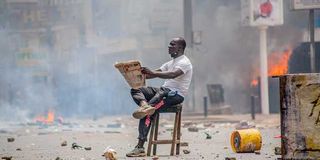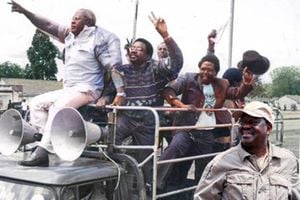
A protester reads a newspaper during demonstrations along Tom Mboya Street in Nairobi on July 2, 2024.
The spark that set off the now immortalised “Saba Saba” (Seventh of July) protests happened on July 4, 1990, when Kenneth Matiba and Charles Rubia (both former powerful Kanu politicians) were arrested, and then detained, under the Preservation of Public Security Legislation.
This was a colonial regulation frequently used to remove opponents of the state who had not committed a crime. Rubia had just left the July 4 celebrations at the American Ambassador’s residence and made his way to the Muthaiga Country Club when he was arrested and ‘unceremoniously dragged out of a club meeting’ by 10 policemen.
Raila Odinga, the son of former Kenya People’s Union leader Jaramogi Oginga Odinga, was also detained.As former Cabinet Ministers with extensive business interests and contacts in all parts of Kenya’s ruling elite, Matiba and Rubia had assumed that they were immune form detention.
Neither former Attorney-General Charles Njonjo nor ex-Vice President Joseph Karanja had been detained when they had fallen from power in 1984 and 1989, respectively.
Both men knew that their carefully devised confrontation with the government was reaching a crisis. If the planned meeting at Kamukunji grounds took place on July 7, 1990, and attracted vast crowds – as seemed almost certain – Kanu would lose face and the opposition’s claim that most Kenyans wanted to end Kanu’s autocracy and corruption, would be strengthened.
The government, however, had not reacted after their two prior press conferences. Although Kanu and the Nairobi Provincial Administration were seriously embarrassed about the prospect of an opposition rally attracting vast crowds, going ahead with the Kamukunji meeting alone would probably not have merited detention of the trio.
President Moi and his inner circle of advisers were, in fact, much more alarmed by Matiba’s and Rubia’s private conversations with Odinga and his son, Raila.
The government panicked when Special Branch officers, who had tailed Matiba and Rubia, reported that the two former ministers had spent a considerable time at a meeting in Agip House, Odinga’s Nairobi business headquarters.
Matiba and Rubia, advised by lawyers Paul Muite and Kamau Kuria, had begun to recruit a team of prominent politicians who had fallen from grace under the Moi regime, to demonstrate the national appeal of their campaign.
Among the seven individuals on their list were Masinde Muliro, Martin Shikuku and Odinga. Odinga, however, was reluctant to re-enter the political fray because his propane gas company had recently secured a sizeable loan from the Industrial Development Bank, a government controlled parastatal, and Odinga wished to secure the loan before risking antagonising the regime with new political adventures.
He, however, promised that he would join the campaign in the not too distant future.In order to gain Odinga’s support, Matiba and Rubia even proposed that Odinga should be the Opposition leader, in order to rebuild the Kikuyu-Luo alliance of the early 1960s.
When Odinga complained that ‘the first marriage’ had brought few rewards for the Luo and wondered what he would get for ‘a second marriage’, Matiba and Rubia had agreed that he should be the opposition’s future presidential candidate, a key concession which was to have enormous repercussions two years later.
Matiba and Rubia also said that they were considering the establishment of the post of Prime Minister, who would control the ordinary business of the government, leaving the position of President as a symbol of national unity above the political battle. Moi and his Kanu advisers had long feared that Odinga might form a coalition with dissident intellectuals from the University of Nairobi.
The danger of an alliance between Matiba and Odinga posed an even greater threat, frightening Kanu into taking precipitate action.
The President correctly feared that they were plotting to revive the old Kikuyu-Luo alliance which had brought Kenya to independence. Such a coalition would have posed a serious challenge to Kanu, uniting two of the country’s three largest, most educated and economically developed ethnic groups against the ruling party.
In an attempt to head off this coalition, the government detained Matiba and Rubia, to keep them physically out of circulation so that they couldn’t glue terrifying coalitions together, and arrested Raila, a courageous activist who had been detained twice before, as a warning to his father not to become involved.
Despite the state’s ban, the detentions and threats, three days later supporters of the multi-party movement attempted to gather on July 7, 1990 – Saba Saba day – at the Kamukunji grounds where the illegal rally was to have taken place.
Riot police dispersed the crowd with batons and tear gas, igniting three days of continuous rioting in the poorer quarters of Nairobi, especially around the wider Kamkunji area (political meetings would thereafter be referred to as ‘Kamkunjis’).The trouble quickly extended to smaller towns throughout Central Province land, leaving more than 20 dead and over 1,000 arrested before the police could restore order.
Most of the violence occurred in areas that were to become Ford-Asili or DP strongholds, such as Kiambu, Nakuru and Nyeri town. Opposition leaders fled into hiding or, like George Anyona, were arrested as the State’s authority was quickly reasserted.
Kuria, the civil rights lawyer, sought refuge in the American Embassy and Muite also vanished from sight.
Eventually, Kuria was permitted to leave Kenya for the United States, while friends of Muite, who had access to the President, negotiated the Nairobi lawyer’s return from hiding.
By compromising and releasing the dissident lawyers, the Kenya government averted an immediate showdown with the United States, permitting its domestic critics to continue functioning under close supervision.
Opposition had not been crushed and internal and external supporters of multi-party democracy now had two powerful new symbols (Matiba and Raila) of the state’s intolerance around which to mobilise further protests.
In the “Gen Z” protests that no one saw coming, like lava bubbling then blowing out over a supposed dormant volcano (Gen Z was presumed pre-occupied by Tik Tok twerks and CBD street shoots), there are no political leaders, which makes it a truly organic movement, like “Crowd Funding”.
Mobilising themselves through social media, and with a heap-load of legitimate grievances such as unemployment (the Finance Bill being merely a lightning rod for pent up generational frustration), this latest pre-Saba Saba protests have also announced a new generation as organising themselves outside of the “tribal paradigm” that haunted the uhuru generation, Gen X and to a smaller extent, the Millennials. Generation ‘Alpha’ will probably be the first entirely post-ethnic political society.
Because Gen Z, having also paid the price in lives like their ‘Saba Saba’ predecessors 34 years ago, has set alight an Olympian political torch whose flames our leadership has to immediately address.
Or, by the ‘Saba Saba’ of 2027, face the fire next time that may well, by then, be raging out of control.









